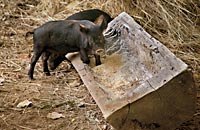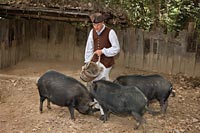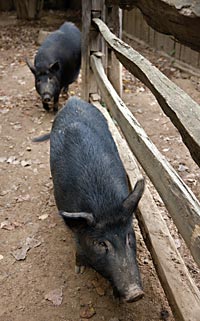Online Extras
Ossabaw Island Pigs Slideshow


Young Ossabaws, the pigs Colonial Williamsburg chose for its rare breed program of animals to represent eigtheenth-century livestock.

At Great Hopes Plantation, Wayne Randolph feeds, cares for, and interprets the Ossabaws that arrive each year from Mount Vernon.

In the eighteenth century, Ossabaws were set free to forage in the woods around Williamsburg, often to the harm of crops on unfenced farm fields.
Ossabaw Island Pigs
Feral American Breed Provides 400-Year-Old Genetic Link between Past and Present
by Ed CrewsPork-loving British North American colonists consumed nearly every part of the pig but its squeal. Eighteenth-century Virginians wolfed down bacon, chops, livers, hearts, and lungs, preserved the meat with salt and smoke, and, in the process, created a delicacy—the Virginia ham.
Because of the hog’s popularity, Colonial Williamsburg presents pigs in educational programs about 1700s animal husbandry and culinary practices. It uses Ossabaw Island pigs, an American feral species, which resemble their colonial counterparts.
“A number of historic sites want pigs that look like eighteenth-century pigs,” said Elaine Shirley, manager of rare breeds for the coach and livestock department. “Their hair was heavy because they lived outside, and they were dark and oval. Today, pigs are rectangular and pink.”
Ossabaw Island pigs have the look such places as Mount Vernon and Colonial Williamsburg are after. Typically black, they also come in gray, tan, red, and, occasionally, white. They have thick coats, upright ears, and long snouts. In their natural habitat, they rarely exceed 20 inches in height or 100 pounds. Their demeanor is different from that of modern pigs.
“Pigs tend to respond to people. Humans tend to like pigs,” Shirley said. “They often will run over to anybody who calls: ‘Piggy, piggy, piggy.’”
Odds are good, though, that Ossabaw Island pigs will be more standoffish than the average twenty-first-century hogs. Biologists discovered that in their original habitat off the Georgia coast the creatures could be aggressive.
When guests see the hogs and talk to interpreters, they are sometimes surprised to learn how important pigs were to colonists. Hogs were among the first newcomers to the New World. They supplied protein for settlers’ diets and required relatively little attention. Farmers turned the animals loose in the woods to grow fat on native plants.
Hogs, however, could do ecological damage and were so ravenous that colonists fenced their gardens to try to protect them from porcine predators. Virginian Landon Carter wrote in 1774, however, that “they ever will trespass and really no fences can turn them.”
Virginians ate all sorts of pork products and exported them, too. Virginia hams found ready buyers in New England, throughout the Caribbean, and in Great Britain. By the late 1600s, Virginia hams were among the world’s best.
Colonial Williamsburg began using Ossabaw Island pigs in 2005. Every summer, Mount Vernon culls its herd to control its size and improve its stock, and sends about seven animals to Williamsburg. The new arrivals go into a pen at Great Hopes Plantation, where they are fattened. In the winter, they are slaughtered. The carcasses go to the Randolph Kitchen, where interpreters butcher the meat, prepare fresh dishes, and salt hams for preservation.
Colonial Williamsburg wants the breed to have more exposure, hoping that will help save the animals from extinction. For about 400 years, Ossabaws have flourished on their namesake Georgia home, a 25,056-acre island in the Atlantic about twenty miles south of Savannah. Historians believe Spanish explorers left the hogs there in the 1500s. The animals thrived in the island’s diverse ecosystem, a mixture of salt marshes, freshwater ponds, forest, sandy beaches, and dunes.
Humans have inhabited the island for 4,000 years. Native Americans were followed by Spanish missionaries, cotton planters, slaves, Civil War soldiers, freedmen, millionaires, and artists.
In the 1920s, the island attracted a wealthy couple—Dr. Henry Norton Torrey and his wife, Nell, of Detroit. They bought Ossabaw and built a mansion. Their home became a haven for such Americans as car baron Henry Ford. The Torreys’s daughter, Eleanor Torrey West, inherited the island and turned it into a retreat for artists and thinkers. When the United States’ economy boomed after World War II and East Coast beachfront land advanced spectacularly in price, she got purchase offers.
West rejected all bids. She decided to do all she could to protect Ossabaw from development. In 1977, she sold a purchase option to the Nature Conservancy of Georgia. The state of Georgia picked up the option in 1978, bought the site, and operates it as a nature preserve.
The protection does not guarantee the Ossabaw Island pigs’ survival. Their feeding habits threaten other wildlife, especially loggerhead turtles. Nobody is sure how to solve the problem. Quarantined to protect domesticated animals, the hogs cannot simply be moved to the mainland. The Ossabaws that are off the island were sent away years ago, before restrictions applied. Some favor eradicating the pigs. For the time being, controlled hunts keep the island’s pig herd at a manageable size.
Aspects of the pigs’ adaptations to their island habitat fascinate scientists. For example, Ossabaw Island females have reduced ovulation rates. Regardless of sex, all the pigs’ kidneys can tolerate high levels of saltwater. Otherwise healthy, all Ossabaws have low-grade diabetes. And, perhaps most intriguing, all can store more fat than any other hog. That allows the animals to feed during times of plenty, and to survive during times of want. Researchers studying diabetes, growth hormones, fat storage, and obesity are interested in Ossabaw Island pigs.
“These pigs are a feral breed,” Shirley said. “Being feral, they have been shaped almost exclusively by natural selection. Europe does not have feral breeds, but the United States does because it had a frontier. Feral animals are a reservoir of genetic information. They are hardy and can survive without help.
“Their value is that, to a certain extent, we’ve gotten rid of certain animal features through commercial farming and breeding. But someday we may need the qualities that have been lost. Protecting animals, like the Ossabaw Island hogs, ensures genetic diversity.”
Ed Crews, a Richmond-based writer, contributed to the spring 2009 journal an article on Colonial Williamsburg’s working carts and wagons.
